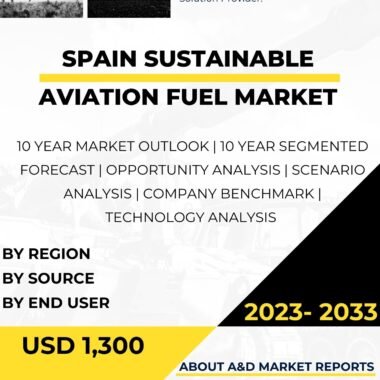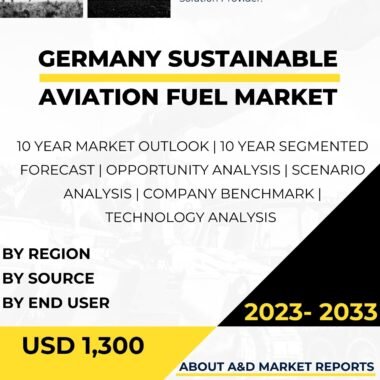Description
The Sustainable Aviation Fuel (SAF) market in Malaysia has seen significant growth and development in recent years, reflecting the country’s commitment to sustainability and its efforts to reduce greenhouse gas emissions in the aviation sector. Sustainable aviation fuel, also known as biojet fuel or renewable jet fuel, is a type of aviation fuel derived from renewable feedstocks such as waste oils, agricultural residues, and non-food crops. The adoption of SAF in the aviation industry enables Malaysia to reduce its carbon footprint, support the global fight against climate change, and ensure a more environmentally-friendly aviation sector.
As a nation with a rapidly growing aviation industry and increasing air travel demand, Malaysia faces challenges in mitigating the environmental impact of aviation. The aviation sector is a significant contributor to greenhouse gas emissions, primarily due to the burning of conventional jet fuel. SAF offers a viable alternative to traditional fossil fuels, as it can significantly reduce the carbon dioxide emissions associated with air travel.
The Sustainable Aviation Fuel market in Malaysia has witnessed growing interest from various stakeholders, including airlines, airport operators, government agencies, and the private sector. Key players in the aviation industry recognize the importance of transitioning to sustainable fuels to achieve long-term environmental sustainability and comply with international climate agreements.
Moreover, the adoption of SAF aligns with Malaysia’s commitment to achieving the United Nations Sustainable Development Goals and reducing the country’s carbon footprint. By promoting the use of renewable and sustainable aviation fuels, Malaysia can contribute to global efforts to limit global warming and combat climate change.
The Malaysian government and aviation authorities have shown support for sustainable aviation fuel initiatives through policy measures and incentives. These measures include promoting research and development in sustainable fuels, offering financial incentives to encourage the use of SAF, and collaborating with international partners to expand the availability of renewable jet fuel in the country.
Additionally, Malaysia’s geographic location and abundant natural resources provide potential opportunities for the production of sustainable aviation fuel feedstocks. Biomass, such as palm oil waste, used cooking oil, and other agricultural residues, can serve as valuable raw materials for SAF production. By leveraging these resources, Malaysia can develop a robust and sustainable supply chain for aviation biofuels.
While the Sustainable Aviation Fuel market in Malaysia shows promise, it is not without challenges. One of the primary hurdles is the higher cost of producing SAF compared to conventional jet fuel. The production process for sustainable aviation fuel involves complex technologies and additional refining steps, making it currently more expensive than traditional jet fuel. As a result, the widespread adoption of SAF in Malaysia and globally is hampered by economic considerations.
Moreover, ensuring a steady and reliable supply of sustainable aviation fuel feedstocks is crucial for the long-term viability of SAF. The development of a sustainable and resilient feedstock supply chain is essential to meet the increasing demand for biojet fuel while minimizing environmental impacts and avoiding competition with food production.
Addressing the infrastructure challenges is also critical for the successful implementation of SAF in Malaysia. Adapting existing infrastructure, such as fuel storage and distribution facilities at airports, to accommodate the blending and handling of sustainable aviation fuel requires careful planning and investment.
Looking ahead, the Sustainable Aviation Fuel market in Malaysia is poised for further growth. The government’s commitment to sustainability, combined with the aviation industry’s increasing awareness of environmental responsibilities, will drive continued investments in SAF initiatives. As the technology and production processes for sustainable aviation fuel continue to improve and mature, the cost of SAF is expected to decrease, making it a more competitive alternative to conventional jet fuel.
Moreover, international collaborations and partnerships can play a significant role in expanding the availability of SAF in Malaysia. Collaboration with other countries, organizations, and industry stakeholders can facilitate knowledge sharing, technology transfer, and joint investment in sustainable aviation fuel projects.
In conclusion, the Sustainable Aviation Fuel market in Malaysia has experienced significant progress in recent years. The country’s commitment to sustainability and efforts to reduce greenhouse gas emissions in the aviation sector have paved the way for the adoption of renewable jet fuel. SAF offers an environmentally-friendly alternative to conventional jet fuel, reducing carbon dioxide emissions and contributing to global efforts to combat climate change.
However, challenges related to cost, feedstock supply, and infrastructure must be addressed proactively to accelerate the adoption of SAF in Malaysia and ensure a sustainable aviation industry. By promoting research and development, offering incentives, and fostering international collaborations, Malaysia can play a leading role in the global shift towards more sustainable aviation fuels, ultimately creating a greener and more environmentally-friendly aviation sector for the future.




